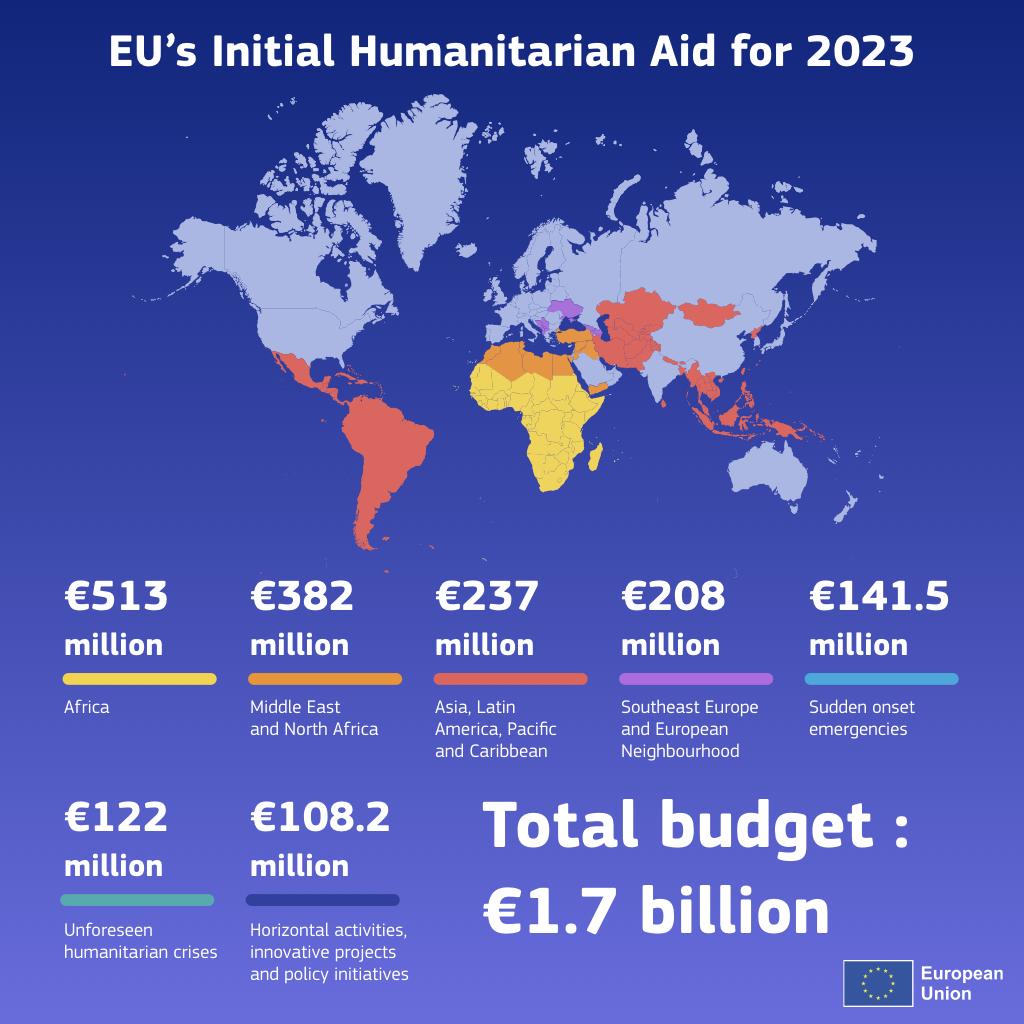Amid rising global humanitarian needs, the European Commission has announced on Wednesday that its initial annual humanitarian aid budget will grow to €1.7 billion in 2023, an increase of about €200 million compared to the previous year. In 2022, the European Union's (EU) initial humanitarian aid budget was €1.5 billion.
“Humanitarian needs are rising steeply. Russia’s war of aggression against Ukraine has made a bad situation dramatically worse. Today, the number of people in need of life-saving assistance worldwide is higher than the population of the US,” said Janez Lenarčič, Commissioner for Crisis Management and European Emergency Response Coordinator.
“The key drivers remain conflicts, increasingly joined also by severe implications of climate change. They are overwhelmingly the result of human action — or indeed inaction, when the conflict parties and international community as a whole fail to resolve steadily growing number of protracted conflicts or work towards preventing new ones.”
In 2023, the United Nations estimates that a record 339 million people will need humanitarian assistance and protection - a significant increase from 274 million people at the beginning of 2022. Human-induced humanitarian crises, resulting from wars with often widespread violations of international humanitarian law, conflicts or outbreaks of violence are the main source of humanitarian needs in the world.
The EU's humanitarian assistance helps millions of vulnerable people, including forcibly displaced people or trapped populations, as well as host communities. The needs resulting from such humanitarian crises are often further exacerbated by disasters triggered by natural hazards, such as drought or floods, fueled by climate change.
Since climate change is increasing communities' vulnerability to humanitarian crises, EU funding will also be aimed at those in disaster-prone countries to prepare better for various natural hazards, such as floods, forest fires, earthquakes, and cyclones. EU humanitarian aid in 2023 will be allocated to regions and specific causes.

€207.8 million will be directed to Southeast Europe and the European Neighborhood addressing mostly the consequences of Russia's war of aggression in Ukraine, as well as funding projects for ongoing needs in the Western Balkans, the Caucasus, and the effects of the Syria crisis in Turkey.
€181.5 million will support those affected by placed by conflict, insecurity, forced displacement and climate shocks in the Sahel (Burkina Faso, Mali, Mauritania, and Niger), the Central African Republic and the Lake Chad basin (Chad, Cameroon, and Nigeria), which result in large-scale displacement, disruption of livelihoods and lack of access to basic services.
€330.7 million go to programs in East and Southern Africa to address the needs of the people affected by long-term conflict in the Democratic Republic of Congo and those displaced by climate change and armed conflicts in Sudan, South Sudan, Uganda and the Horn of Africa (Djibouti, Ethiopia, Kenya and Ethiopia).
€382.2 million of EU humanitarian funding will be allocated in the Middle East and North Africa to address the ongoing regional crisis in Yemen, Syria and its neighboring countries, as well as the critical situation of the Sahrawi refugees.
€237 million in humanitarian assistance will help the most vulnerable populations in Asia and Latin America. In Asia, the funding will address the Afghanistan and Rohingya crises (Bangladesh and Myanmar) as well the impact of climate change in the region. In Latin America and the Caribbean, the EU will continue its support on the impact of the crisis in Venezuela, the humanitarian consequences of the armed conflicts in Colombia as well as pervasive violence in Haiti, and Central America and Mexico.
€141.5 million will be used to answer to sudden onset emergencies in 2023. €122 million EUR are reserved for unforeseen humanitarian crises that can arise throughout the year. €108.2 million will be committed to horizontal activities, innovative projects and policy initiatives.
“The European Commission’s funding for 2023 will continue to make sure that humanitarian assistance is available for most vulnerable, no matter who and where they are. However, this should be a shared responsibility for the entire global community. Currently, only 10 largest donors provide for more than 80% of all humanitarian funding. Clearly, a fairer sharing of this global responsibility is needed. There are several countries with the potential to step up and do their part, and increasingly also actors from the private sector,” Mr. Lenarčič said.
The European Union has been providing humanitarian aid since 1992 in over 110 countries, reaching millions of people across the globe each year. In 2022, the European Union was the third largest humanitarian aid donor in the world after the United States and Germany. EU assistance is delivered through humanitarian partner organizations, such as European humanitarian non-governmental organizations (NGOs), Red Cross societies, United Nations agencies, other international organizations, and specialized agencies in the member states.
The European Commission's Directorate-General for European Civil Protection and Humanitarian Aid Operations (ECHO) is responsible for both humanitarian aid and civil protection. Established in 1992, ECHO is one of the world's largest players in the field of humanitarian assistance. In the case of humanitarian aid, ECHO shares competence with European Union member states.
Further information
Full text: Humanitarian aid: EU increases funding to €1.7 billion for 2023. Directorate-General for European Civil Protection and Humanitarian Aid Operations (ECHO), press release, published January 18, 2023
https://civil-protection-humanitarian-aid.ec.europa.eu/news-stories/news/humanitarian-aid-eu-increases-funding-eu17-billion-2023-2023-01-18_en